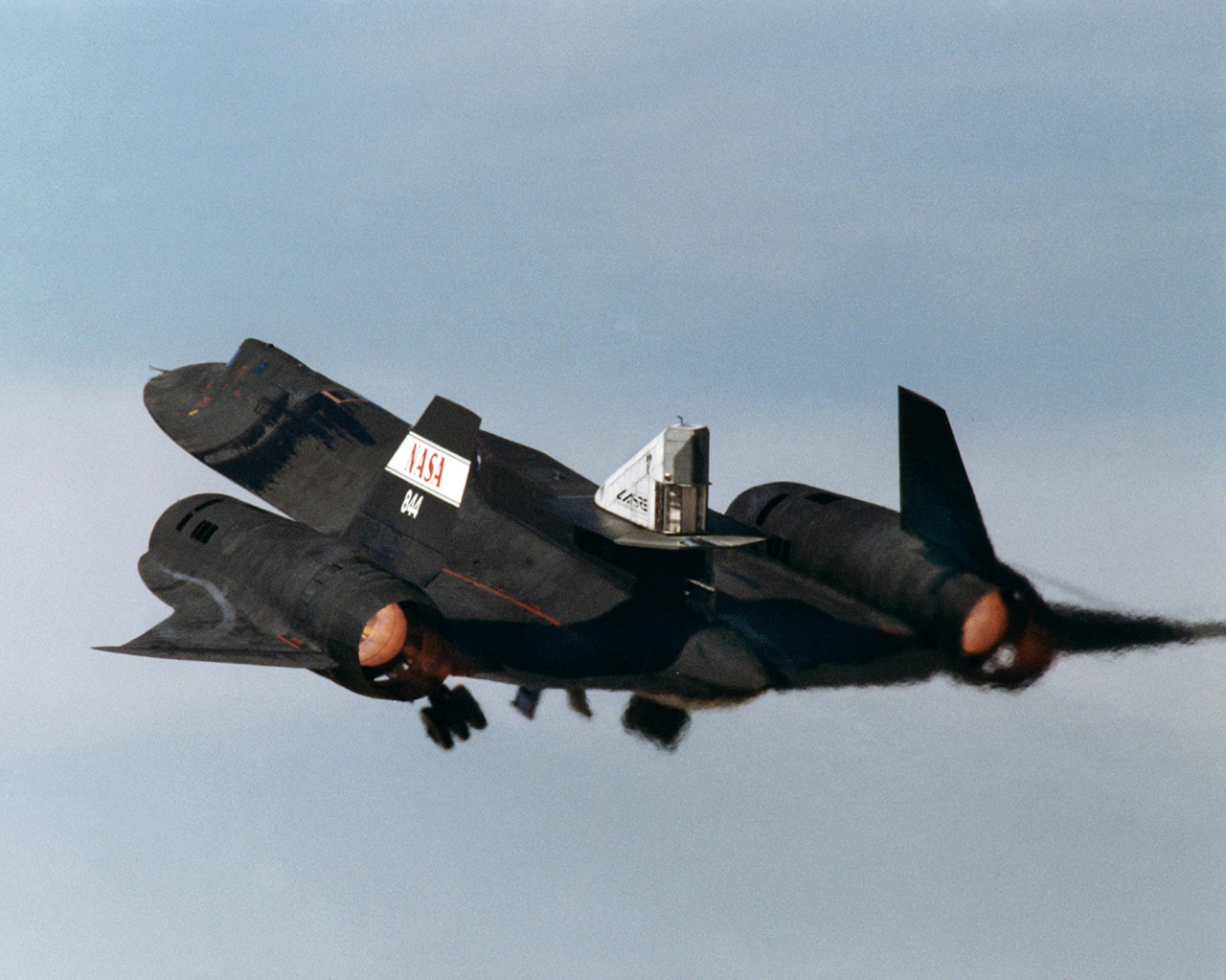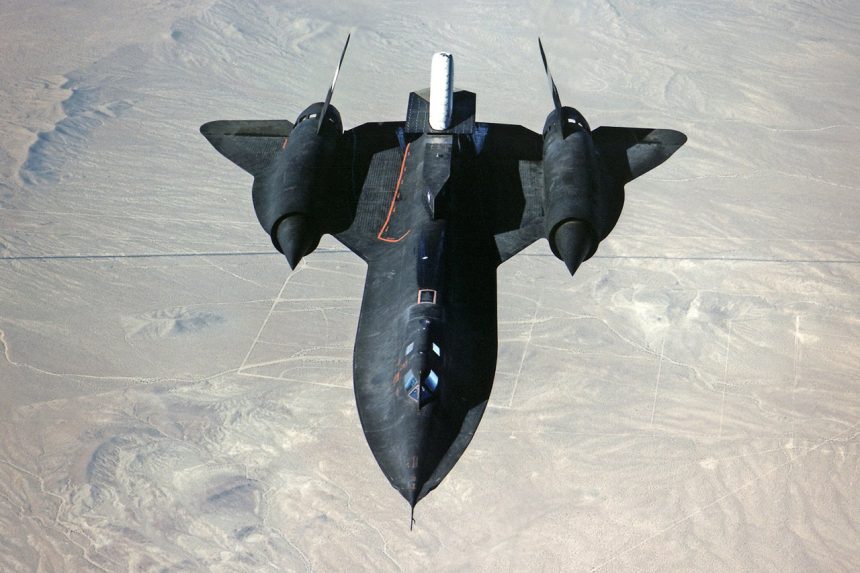The iconic SR-71 was used by NASA to undertake a series of experiments. To carry out some of these testing activities the Blackbird was installed an interesting pod.
According to official records, NASA has operated a fleet of seven Blackbirds:
YF-12A (60-6935) – December 1969 to November 1979
YF-12A (60-6936) – March 1970 to June 1971
SR-71A/YF-12C (61-7951/“06937”) – July 1971 to December 1978
SR-71A (61-7971/NASA 832) – January 1995 to June 1996
SR-71A (61-7967) – August 1995 to January 1996
SR-71B (61-7956/NASA 831) – July 1991 to October 1997
SR-71A (61-7980/NASA 844) – September 1992 to October 1999
The last SR-71 flight was made on Oct. 9, 1999, at the Edwards AFB air show. The aircraft used was NASA 844 that flew to 80,100 feet and Mach 3.21 in the very last flight of any Blackbird. Actually, the aircraft was also scheduled to make a flight the following day, but a fuel leak grounded the aircraft and prevented it from flying again. The NASA SR-71s were then put in flyable storage, where they remained until 2002. Then, they were sent to museums.
Throughout their career at NASA, Blackbirds have served as test beds for a series of high-speed and high-altitude research programs:
“As research platforms, the aircraft can cruise at Mach 3 for more than one hour. For thermal experiments, this can produce heat soak temperatures of over 600 degrees Fahrenheit (F). This operating environment makes these aircraft excellent platforms to carry out research and experiments in a variety of areas — aerodynamics, propulsion, structures, thermal protection materials, high-speed and high-temperature instrumentation, atmospheric studies, and sonic boom characterization,” says NASA Dryden’s Blackbird website.
“The SR-71 was used in a program to study ways of reducing sonic booms or over pressures that are heard on the ground, much like sharp thunderclaps, when an aircraft exceeds the speed of sound. Data from this Sonic Boom Mitigation Study could eventually lead to aircraft designs that would reduce the “peak” overpressures of sonic booms and minimize the startling affect they produce on the ground.”

Among the major experiments flown with the NASA SR-71s, there was a laser air data collection system that used laser light, instead of air pressure measured by pitot tubes and vanes extending into the airstream, to determine airspeed, angle of attack, vertical speed, and other attitude reference data.
Another project involved a Dryden’s SR-71 as a platform to film with an ultraviolet video camera, celestial objects in wavelenghts that are blocked to ground-based astronomers. Moreover, the SR-71 was also a testbed in the development of Motorola’s IRIDIUM commercial satellite-based, instant wireless personal communications network, acting as a surrogate satellite for transmitters and receivers on the ground.
Between 1997 and 1998, one NASA Blackbird was used for the Linear Aerospike Rocket Engine, or LASRE Experiment, whose goal was to provide data to validate the computational predictive tools used to foresee the aerodynamic performance of future single-stage-to-orbit reusable launch vehicles (SSTO RLVs).

As part of the LASRE experiment, the Blackbird completed seven initial research flights from Edwards. The first two flights were used to determine the aerodynamic characteristics of the LASRE apparatus (pod) on the back of the SR-71 whereas five later flights focused on the experiment itself.
The LASRE experiment itself was a 20-percent-scale, half-span model of a lifting body shape (X-33) without the fins. It was rotated 90 degrees and equipped with eight thrust cells of an aerospike engine and was mounted on a housing known as the “canoe,” which contained the gaseous hydrogen, helium, and instrumentation gear. The model, engine, and canoe together were called a “pod.” The experiment focused on determining how a reusable launch vehicle’s engine flume would affect the aerodynamics of its lifting-body shape at specific altitudes and speeds. The interaction of the aerodynamic flow with the engine plume could create drag; design refinements looked at minimizing this interaction. The entire pod was 41 feet in length and weighed 14,300 pounds.
Two test flights were used to cycle gaseous helium and liquid nitrogen through the experiment to check its plumbing system for leaks and to test engine operational characteristics. During the other three flights, liquid oxygen was cycled through the engine. Two engine hot-firings were also completed on the ground. A final hot-fire test flight was canceled because of liquid oxygen leaks in the test apparatus.
The experimental pod was mounted on NASA’s SR-71 #844. Lockheed Martin may use the information gained from the LASRE and X-33 Advanced Technology Demonstrator Projects to develop a potential future reusable launch vehicle.

NASA and Lockheed Martin were partners in the X-33 program through a cooperative agreement but the program was cancelled in 2001.

Throughout its career, the high-altitude SR-71s, involved in test flights as well as operative missions, have probably contributed to fuel UFO (Unidentified Flying Object) conspiracy theories. For instance, according to CIA high-altitude testing of the then new and secret U-2 led to an increase in reports of UFOs:
“According to later estimates from CIA officials who worked on the U-2 project and the OXCART (SR-71, or Blackbird) project, over half of all UFO reports from the late 1950s through the 1960s were accounted for by manned reconnaissance flights (namely the U-2) over the United States. This led the Air Force to make misleading and deceptive statements to the public in order to allay public fears and to protect an extraordinarily sensitive national security project. While perhaps justified, this deception added fuel to the later conspiracy theories and the coverup controversy of the 1970s. The percentage of what the Air Force considered unexplained UFO sightings fell to 5.9 percent in 1955 and to 4 percent in 1956.”
Fast forward to 2017, we can’t but notice that, among the theories surrounding the footage of an unidentified flying object (UFO) filmed by an F/A-18F Super Hornet in 2004, there is also the one that the weird “capsule-shaped” object might have been some sort of secret aerial vehicle during a test mission rather than an alien spacecraft…. And it would not be the first time.









